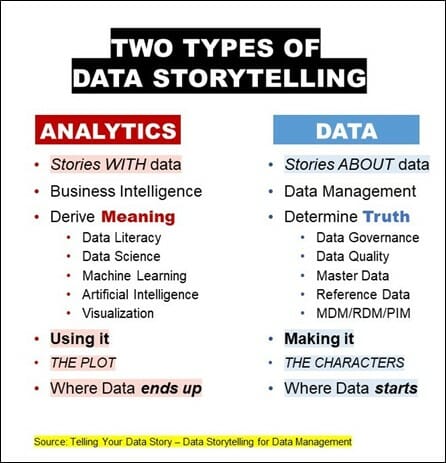All data management professionals should understand the two types of data storytelling – one is just as important as the other
There are two types of data storytelling. Stories WITH data (to support the use of analytics) and stories ABOUT data (reinforcing the importance of data management).
The more popular type of data storytelling is about analytics. It guides the use of insight to drive business action. Many excellent thought leaders have created content to help analytics and data science professionals. Coupled with data literacy, these efforts go a long way to assist in the effective delivery and use of insights in an enterprise. There are plenty of industry experts who lead formal practices in how to better communicate with data through graphics, display, visualization, dashboarding and business-building techniques. It is a deep and vital knowledge area of crucial importance to every data-driven organization.
Reading Gartner’s definition of data literacy – the ability to read, write, and communicate with data in context – there is no mention about data management. It seems that the majority of time and focus in the fields of Data Storytelling and Data Literacy is spent explaining analytics.
It is time, therefore, to expand the realm of Data Storytelling to recognize the role of data management. This is the story about why data is vital to an organization and why it needs to be managed strategically. While an analytics data story is storytelling with data and using it, the data management story is about data and making it. Both are important. They are connected. Segmenting these two data storytelling types helps clarify focus and purpose. Every organization needs to do both.
For more context, there are two big buckets in the broader data space: data (meaning data management) and analytics (some sort of business intelligence). Analytics, and the extended capabilities based on business intelligence, such as artificial intelligence, machine learning, data science, and data visualization, focus on making data more useful for an organization. Doing this can derive MEANING.
The activities around data management ensure data is trustworthy for an organization: data governance, data quality, data catalogs, business glossaries, master data, reference data, metadata, MDM, RDM, PIM. These functions help determine the TRUTH. A simple data philosophy can be reduced into three words: TRUTH before MEANING.
Data Storytelling is not just about analytics. However, the content published about data storytelling focuses on tips about visualization, dashboards, charts, graphs, and other ways to explain analytics. Analytics can bring all sorts of value to an enterprise if the data is trustworthy. Devoid of data management, however, analytics data storytellers have no story to tell— analytics may create the plot, but the characters come from data management.

Here’s a simple example of an analytics data story headline:
Our market share is down in our top regions, so we should increase promotional pricing.
Assume this analytics data storyteller has proven that market share in certain regions is down and recommends that incentivizing prospects with a new offer will help drive volume and potentially lead to share increases. All the characters in this story come from data management. Calculating market share requires a clear definition of categories and competitors. Sales is an aggregated form of transactions. Transactions are made up of the intersection of a customer record and a product record at a given time for a particular price – essentially a relationship and a brand. Data management governs the definition of customer and product. Standardized market definitions are agreed upon through the work of data management. Yes, the business has input into the definitions, but the story falls apart if those entities are not clearly defined. Questions abound: What are the top regions? Which customers? What products?
Every enterprise has a data management story to tell. They must tell it for two reasons: First, investment in data management is a crucial component for the success of the business. This investment should be an on-going, strategic initiative, not a one-time ad-hoc project. Most C-Level business executives, company boards, and business stakeholders don’t understand that. It is not because they aren’t smart or aware—they simply haven’t been exposed to the need for data management in a business-accessible way with a strategic perspective. To get their attention, they need to hear a narrative that captures their hearts and minds and convinces them that having all the data management functions is not an option.
Secondly, the louder, cooler, and in many cases, “sexier” trends fail without proper data management. Many massive investments are woefully underperforming. The value of every digitally transformative customer-facing initiative, every data science and analytics-based project, every as-a-service offering, every foray into e-commerce, and every enterprise software implementation is inextricably linked to the successful output of data management efforts. Although it is a simple function of garbage in/garbage out, that slogan rarely serves to drive any sustainable executive action.
Data management professionals must speak up. How many remain silent when a BI thought-leader boasts, “without analytics, data is just a cost center” or “data has no value unless it is made into analysis.” That is disparaging important work! A baker would never say, “flour is worthless unless I make it into bread,” because they have respect for the ingredients. There is no doubt that business intelligence provides incredible capabilities, but without proper data management, those efforts are futile. Challenge the analytics community to end this type of zero-sum portrayal of data vs. analytics value. It doesn’t help either group gain executive support. All data management professionals must learn to tell the story of data management.
Conclusion
Although, data storytelling and data literacy are some of the hottest non-technical trends in the technology-related space, neither of them directly supports the value of data management. To be successful in leveraging enterprise data and analytics, enterprise data leaders need to recognize and support the two types of data storytelling. Data management stories cover where data starts – data analytics stories are about where data ends up. This isn’t Sophie’s Choice – you need both!
Excerpted with permission by Technics Publications from TELLING YOUR DATA STORY – Data Storytelling for Data Management by Scott Taylor. https://technicspub.com/data-storytelling/
Or at:







